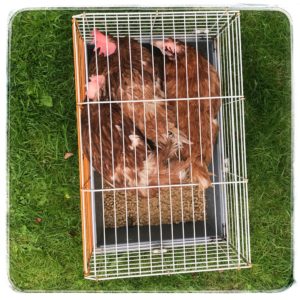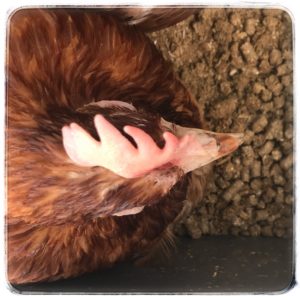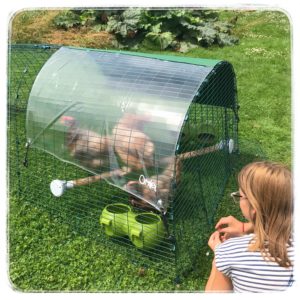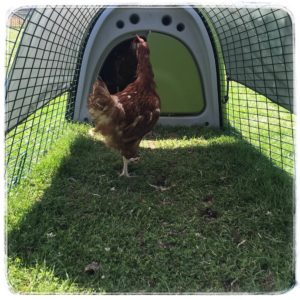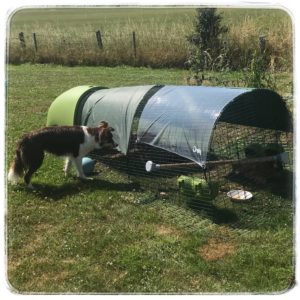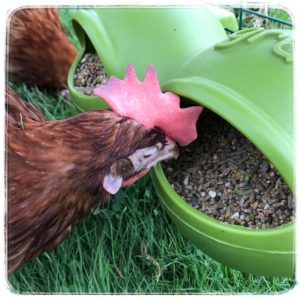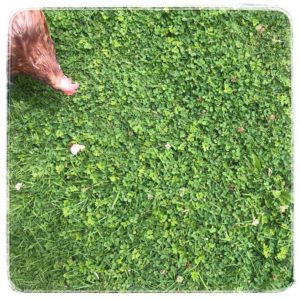Nathalie is the owner of the Instagram account My Backyard Paradise. Together with her husband and their three teenage daughters she runs her own ‘mini backyard farm’ in Belgium. The beautiful pictures she shares with her Instagram followers show that this truly is a backyard paradise. In June 2018 Nathalie decided to extend her mini farm with three ex-battery hens. Follow their journey to recovery in the two-part photo diary she kept for us.
A laying hen, one that can lay up to 300 eggs a year, is what we were missing. During autumn, our purebred chickens don’t lay any eggs for a long time. They instead take spend their time and energy renewing their plumage and waiting for the days to get longer again. Last year we didn’t have any eggs for over 3 months despite having more than ten hens! We decided that if we wanted fresh eggs during autumn, we had to buy laying hens.
We always buy our new chickens from a smaller trader or a hobby breeder, so we can actually see the chickens and know they have access to grass, clean water and decent housing. But we like the idea of rescuing a few laying hens destined for slaughter by giving them a good life in our garden. The life of battery hens ends after just sixteen months. Their bodies need time to recover and their egg production will stop. This means a loss for the industry. Besides that, after each moult the egg production will drop, and the industry does not accept that!
So that’s what we did. First thing to do was find a place where you can rescue commercial laying hens from slaughter. The first option we came across was www.redeenlegkip.be (‘Save a battery hen’), a Belgian website where you can buy or adopt a laying hen. If you decide to adopt a hen, you’ll pay a monthly contribution of €5 and get 24 egg per month in return. When you adopt or buy a chicken, the organization ensures the chickens are collected from the companies and given appropriate first aid. However, we wanted to experience this ourselves. After continuing my search, I came across another Belgian website www.lespoulesheureuses.org (recently also available in France). They give you the opportunity to collect the chickens yourself, so you’ll know the address and code (the one you can find on the egg) of the company.
We then had to wait for the right weather. The best time to save a laying hen is when you can give her the ideal conditions to recover. They often don’t have many feathers left and have probably never been outside their barn, where the temperature is always at least 18 degrees! They’ve never seen rain and you should also be careful with draught and wind. You don’t want them to get ill, they have experienced more than enough stress already.
Week 1
On June 16th 2018, it is finally happening. I reserved three Isa Brown chickens from a code 2 company. Code 2 means the eggs from this company are sold as free-range eggs. Sounds good, you might think…
Free-range eggs from the commercial industry come from chickens that only have access to barns. They have perches, nesting boxes and scratching areas with some straw on the floor. There is a maximum of nine chickens per square meter and debeaking is allowed. This is probably not what most of us have in mind when we think of free-range chickens…
My youngest nine-year-old daughter is joining me on my way to pick up the chickens. I tell her in advance that the chickens will be in a bad shape and will look nothing like the chickens we have at home, that she isn’t allowed to pick them up and cuddle them, and that we have to take care of them first. We are not the only ones here today to buy chickens. An older couple buys two chickens and there is someone with a trailer with 50 chicken cages. People keep on coming. We ask a staff member if we can have three chickens. He looks at my daughter first before turning around to get them for us. Of course, we are not allowed in the barns, we’re not even allowed to take a picture. The chickens we get are in a much better condition than the ones the older couple got, ours still have a lot of feathers. Maybe I shouldn’t have taken my daughter with me, to get a more honest impression of the condition of an average laying hen. The man probably had our daughter in mind when he chose our chickens. After paying €3 per chicken, the life these chickens deserve can finally begin. At home everything is ready for them. After driving 10 minutes, my daughter and I look at each other. It’s smelly in the car. And it’s a strange smell, not like normal chicken manure, but a chemical, unnatural smell. The chickens are quiet, I hope they will survive the one hour drive home…
When we get home, we inspect them carefully. They seem numb, or are they frozen with fear? They still have lots of feathers, but they are dull and not shiny like the feathers of a healthy chicken. Their feathers are tangled and the tail feathers don’t look good at all. Their gaze is blank and their comb is very pale. Their toenails are way too long and curly, and there is manure stuck under them. Clearly, they haven’t been able to scratch around that much. The beaks of our chickens have been trimmed. This means the top of the beak has been cut off when they were only ten days old. This is very painful and is done to prevent feather pecking. Chickens do this when they are stressed, for example due to limited foraging opportunities.
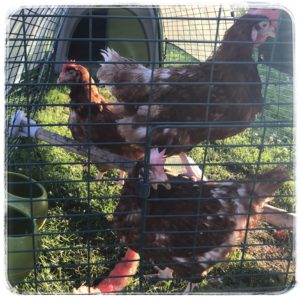
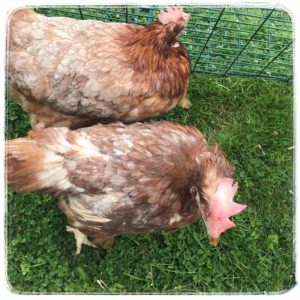
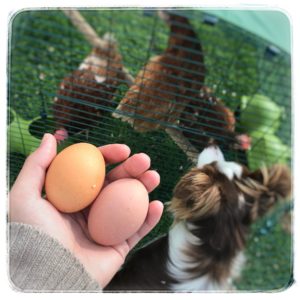
It’s time to treat them against parasites such as lice and worms. We use Diatom Earth, a natural product used against all kinds of parasites. They need to be quarantined first. For this, we give them a temporary home in our Eglu Classic from Omlet. It has a 2 meter run and we can easily move it around in the garden so they have access to fresh grass every day. It’s also very easy to clean. We lift the chickens out of their cage and watch carefully how their feet touch the grass for the very first time. They seem surprised and for a few minutes they just stand still, until one hen realizes she can, and is allowed to, move. Slowly but surely, they cautiously start to explore their run. While the children are watching the chickens, I add the first dose of medication to their drinking water. We use Avimite, a product against lice and mites. The first week they need this on a daily basis, then weekly for the next five weeks. They soon find their water and it looks like they haven’t had any for days. Usually we don’t feed our chickens layers pellets so I had to buy them, because this is the only thing our new chickens have ever had. In the evening we help the chickens into their Eglu where they can safely spend the night.
When I open the coop the next morning they don’t want to come out. After an hour we get them out of their coop and notice they have already laid three eggs, one in the nesting box and two on the roosting bars. Because of the medication, we cannot eat their eggs for the next few weeks. Sad, but we just don’t want to take any risk. We have to discard them.
The rest of the day the chickens sit outside. They eat clover and grass for the first time and seem to realize this is not bad at all. The second and third night we have to help them into their Eglu, but from then on they finally realize that this is their new home. In the morning they come outside when I open the door and after a few days they only use the nest box to lay their eggs. Their eyes are getting brighter and they start to establish the pecking order. They are more lively than the first few days, but still nothing compared to our other chickens. Although they aren’t afraid anymore when we come near, they don’t allow us to touch them. This is hard for the children who want to cuddle them to make them forget their past. But the chickens first have to get used to their new environment, to us, and to their new life.
Week 2
We only have to repeat the red mite treatment once a week now and we can start with the deworming. This treatment, which they need five days in a row, can also be added to their drinking water. The hens give us two to three eggs every day. It’s now time to gradually change their diet. They are used to their new home, they’re not scared anymore when we come near or when our dog wants to sniff at them. They clearly defined their pecking order. We want the very best for our animals, and this also includes a rich and varied diet. Our chickens get Garvo but our 3 laying hens need something extra, a mineral and vitamin boost. We give them Alfamix, a very rich grain mixture with pellets and amphipods. But when I mix this with their layer pellets, I notice that they only eat their pellets and not the new food. They do eat a lot of grass and clover. Slowly but surely their combs are getting redder.
During the weekend, our youngest daughter decides it is time for them to free range in the garden. They love it, and really enjoy the dust baths. But trying to get them back into their Eglu is less enjoyable. Finally they decide to go back into their home. Our daughter has learnt that they are not ready to discover the great outdoors just yet…
Come back in a couple of weeks time to read part two of the diary!
This entry was posted in Chickens on March 13th, 2019 by linnearask
If you’re a first time chicken keeper just getting started, you will likely be wondering what exactly you need to take care of your new pets. Some things will depend on your garden and how many chickens you will be getting, and others are a standard essential for all chicken keepers. We’ve put together this ultimate chicken keeping checklist for everything you need. Tick things off as you go shopping!
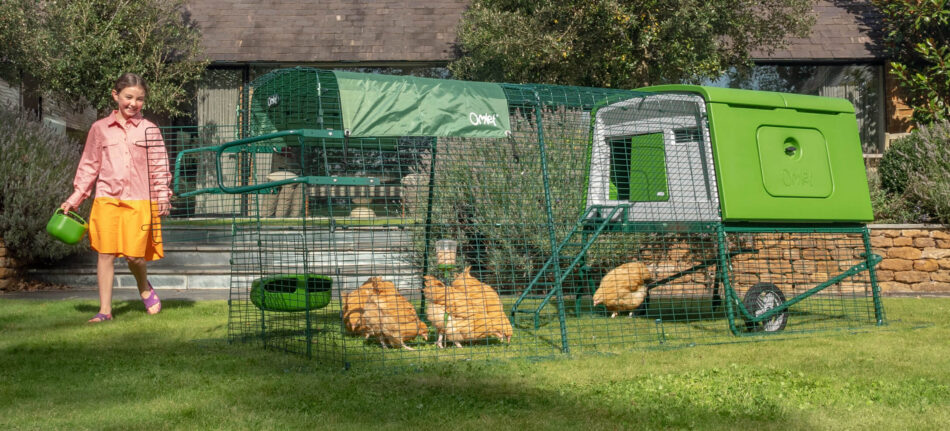
The Chicken Coop
First things first – housing. Your choice here will mainly depend on the number of chickens you plan on getting. At Omlet, we recommend a plastic chicken coop to reduce the risk of red mite infestation and to keep your girls completely weather protected. The traditional wooden chicken coop may look nice but they are harder to maintain and keep waterproof and red mite free.
Our Eglu chicken coops not only look great (available in purple or green), but they are also completely weatherproof, twin-wall insulated, and super easy to clean, making it virtually impossible for red mites to survive.
The Eglu Go Chicken Coop and Eglu Go UP Chicken Coop are a good starting point if you are only planning on getting 2 to 4 chickens. The house is the same, with a pull out droppings tray, nesting area, roosting bars and easy open back door, the only difference is that the Go UP comes on a stand with a ladder up to the coop, making the run taller, giving more space for hentertainment and allowing your chickens to roost off the ground.
The Eglu Cube Chicken Coop is our largest hen house. It is suitable for up to 10 smaller bantam breeds such as Pekins, 6-8 medium sized hens like the Rhode Island Red or 4-5 large breeds like the majestic Cochin. The Cube also has a back door and pull out droppings tray, plus a side egg port for you to easily collect your eggs from the nest box (which is big enough for 3 chickens to lay at once).
The Run
The Eglus are available with a fox resistant chicken run made from strong steel weld mesh, impossible for predators to break. A unique anti-tunnel skirt sits flat on the ground and prevents animals from digging in. Choose your run length based on how many chickens you will be getting and how often you will be able to let your chickens free range. If you start with a smaller run to begin with and realise later on your chickens need more space, we have chicken run extensions available, or you may want to consider a larger Walk in Chicken Run to give your chickens lots of space and make it easier for you to spend time with them and look after them.
A number of accessories are also available for your Eglu run including wheels and run handles to make it quick and easy for one person to move the coop and run to another area of your garden.
Something else you may want to consider for your garden set up is Chicken Fencing. Although not predator proof, chicken fencing allows you to section off an area of your garden to keep your chickens in one place. This is especially useful if you have a larger garden that you don’t want your chickens to get lost in, or if you have a vegetable patch or flower bed to protect. This is best used when you are home or at a time when you know foxes are not about in your area, so you know your girls are safe free ranging outside of their coop run.
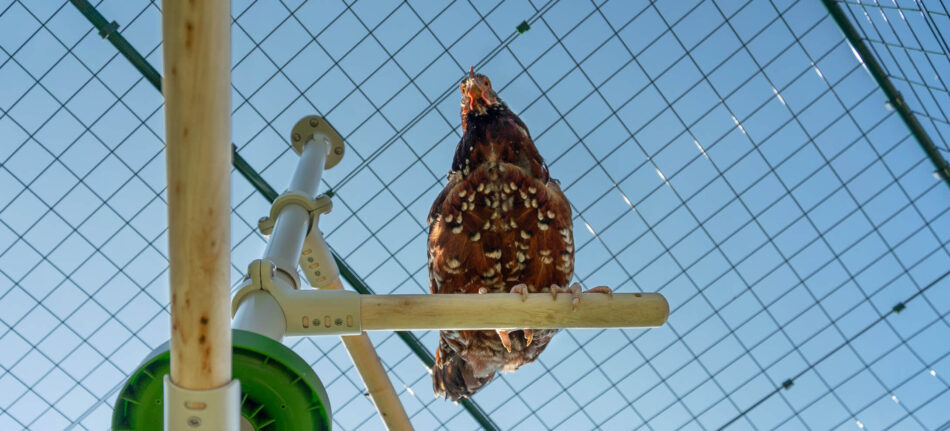
Hentertainment
Like any other animal, chickens can get bored and need good sources of what we like to call hentertainment to keep them occupied when you are not around.
Our Chicken Peck Toys slowly release treats over time while being pecked and offer hens great boredom busting fun. The Omlet Chicken Perch can be placed anywhere on any chicken run, and allows your hens to fulfil their natural desire to perch from the highest point available while in their run during the day.
If you have a larger run or enclosure, you can accessorise it with the amazing PoleTree Chicken Perch Tree. The main pole of the PoleTree attaches to the roof of your run, and you can then add as many poles, perches and accessories as you like, creating an amazing poultry playground!
Weather Protection
For spring and summer time you may want to consider a chicken run shade to give your chickens a cooler area out of the sun where they can chill out.
For winter, an Extreme Temperature Blanket is ideal for keeping the coop warm when temperatures drop below freezing for multiple days in a row. There are also a number of chicken run covers and wind breaks available so your hen can still enjoy time outside while being protected from the elements.
Food
For laying hens you will need to provide layers pellets which offer the protein content they need to stay healthy and regularly lay eggs. A fully grown chicken will typically eat about 120 grams of layers pellets a day. You will also need to provide poultry grit, which is essential for helping chickens digest their food, as they do not have teeth.
Corn is a great treat for hens, but should be limited as it is high in fat. Other treats, such as fruit, green veggies and cereals should also only be given in limited supply to avoid chickens filling up on those rather than the layers pellets.
It also important to ensure fresh water is available at all times – checking and refilling it daily.
Our Eglus all come with a feeder and drinker but you may want to consider buying extra to offer another area in your garden for when they are free ranging, especially important for chickens who don’t like to share with their coop-mates!
Bedding
There are lots of different types of poultry bedding available on the market, and which you choose is entirely dependent on your personal preference. Some to consider include dust extracted wood shavings, straw, chopped cardboard, Aubiose and Easichick.
Cleaning
When you give your chickens’ droppings tray and bedding area its weekly clean, you might want to consider sprinkling some Diatom Powder around to prevent any bugs making a home in your chicken coop, and adding some BioDri to bedding will help to sanitise the litter, make it last longer, and reduce the growth of bacteria.
Deep clean your whole coop once a year with a disinfectant such as Johnson’s Clean ‘n’ Safe to ensure the coop is spotless.
Last but not least: Chickens!
When you have everything in place and are ready to get some chickens, we strongly recommend looking to charities to rescue an ex-battery hen. While these hens may be a little more wary of their new home and the strange environment they are not used to, they will soon come round and settle in and be a great layer for you and your family.
Ultimate Chicken Keeping Checklist
- Coop
- Run
- Fencing
- Run wheels/handles
- Run shade and covers
- Toys; perches, treat dispensers
- Feeders and drinkers
- Layers pellets
- Corn
- Grit
- Bedding
- Diatom powder
- BioDri
- Chicken-safe Disinfectant
This entry was posted in Chickens on March 10th, 2019 by chloewelch
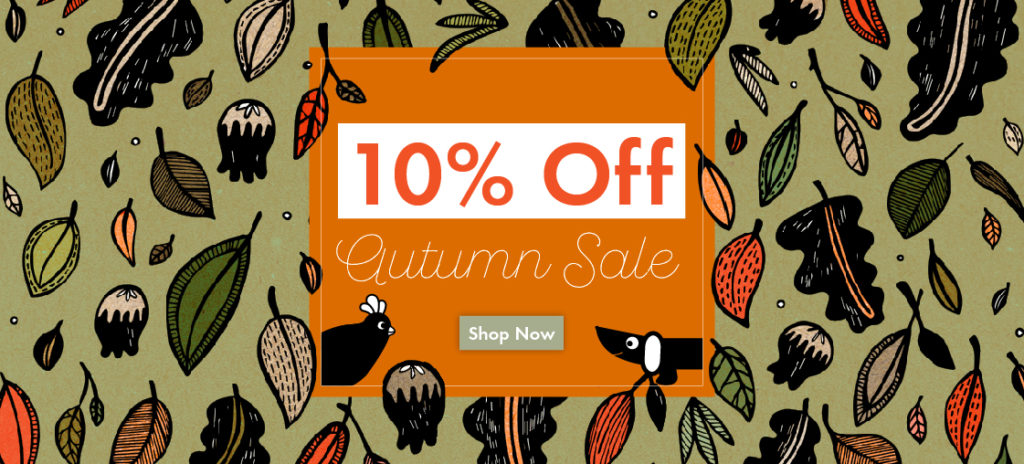
Get 10% off EVERYTHING online until the 24th of March. Treat your pup to a new doggy den, start your chicken keeping journey with an Eglu or build your rabbit their dream warren with the Zippi Tunnels – now all with 10% off.
Terms and Conditions
10% off promotion is only valid from 08/03/19 – midnight on 24/03/19 ACT. No promo code required. Subject to availability. Omlet ltd. reserves the right to withdraw the offer at any point. The discount cannot be transferred to delivery or courses. Excludes delivery. Offer is only valid on full priced items and cannot be used on existing discounts or in conjunction with any other offer.
This entry was posted in Offers and promotions on March 8th, 2019 by chloewelch
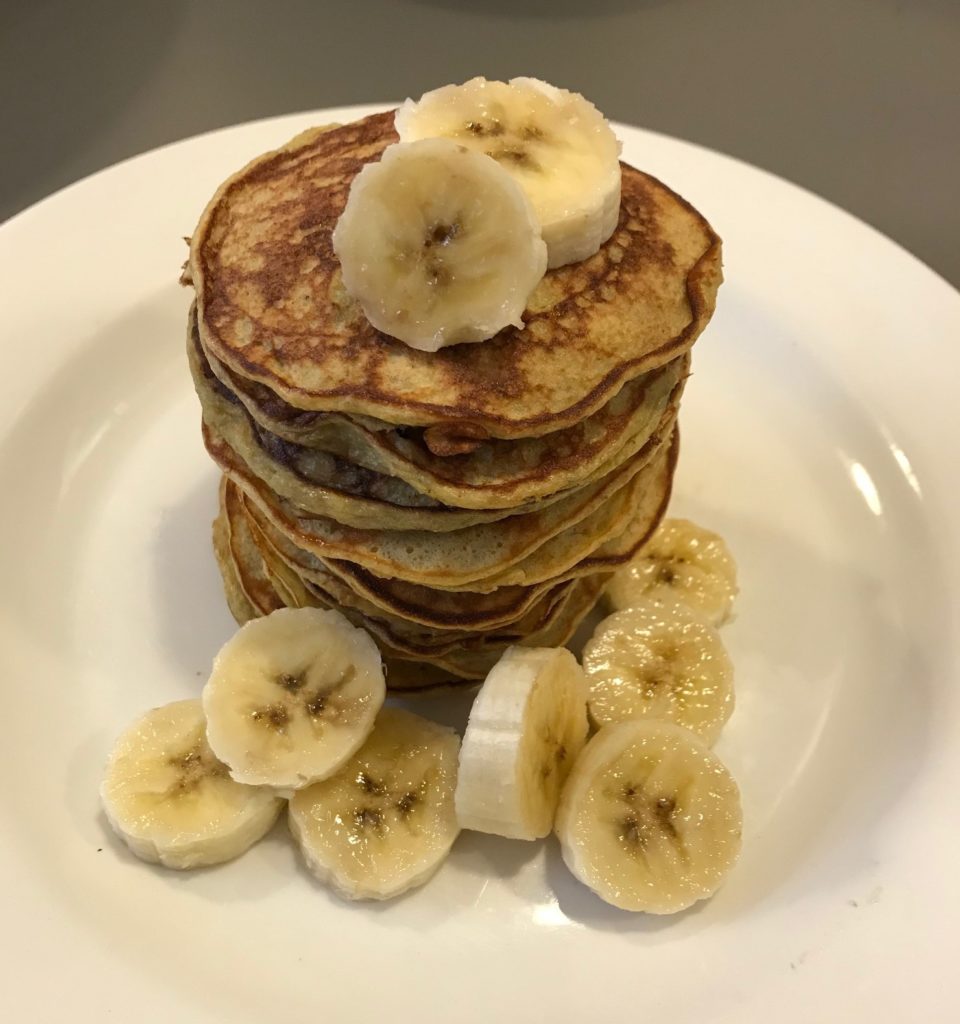
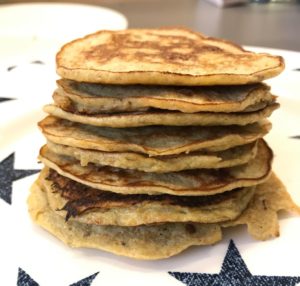
Try something new for your pup and treat them to this dog-friendly pancake recipe with all the trimmings. This is also a delicious, healthy option for humans, too!
All you need for the pancakes are –
- 2 eggs
- 2 ripe bananas
- 1 tablespoon of flour
- Coconut oil spray for frying pan
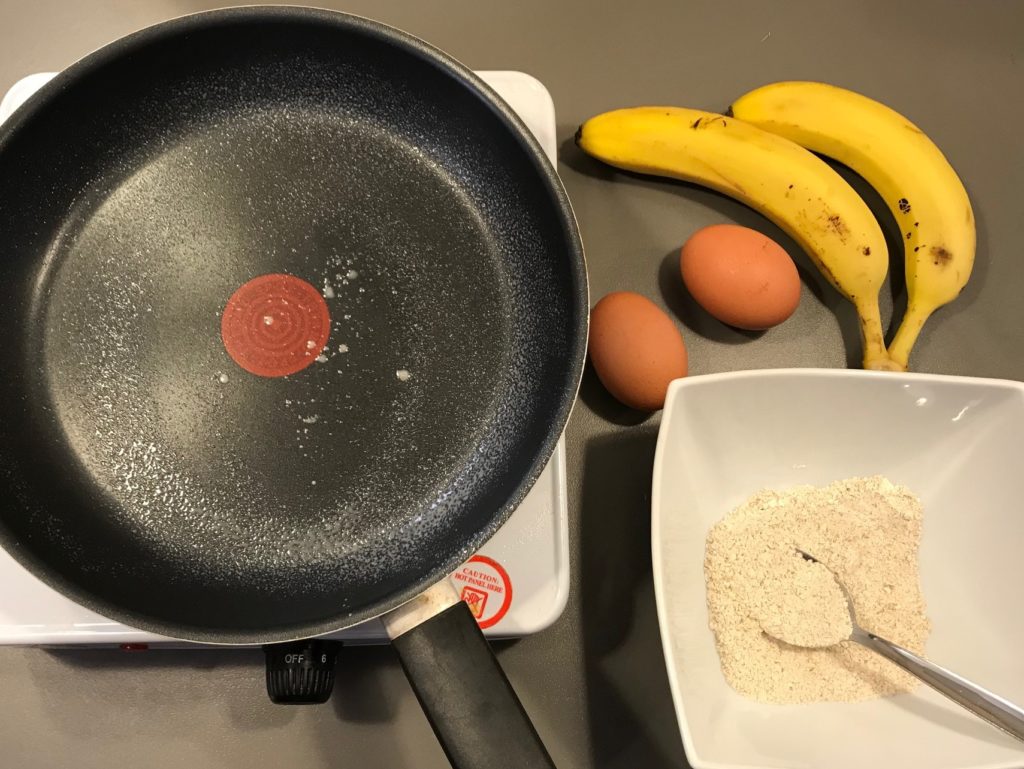
Eggs are a great source of protein for dogs, and are full of vitamins which can benefit their diet. Bananas are also rich in vitamins and minerals, and they also help boost your dog’s immune system and skin health.
Mash up the bananas in a bowl or food processor. Add the eggs and mix. Thicken with flour until the mixture forms a batter-like texture. Spray the frying pan with Coconut Oil Spray on a medium temperature. Add a tablespoon of the mix into the frying pan and cook for 2-3 minutes. Flip and cook the other side. Allow the pancakes to cool before giving to your dog.
Suggested toppings for your dog’s pancakes –
- More bananas!
- Greek yoghurt
- Peanut butter (check there is no xylitol in ingredients)
- Blueberries
- Strawberries
- Apple
- Cottage cheese
- Small cubes of cheddar cheese
- Their own treats!
Flipping fantastic! Join the fun on Instagram and tag us in videos of your dog attempting to catch their pancake using the hashtag #FlippingFido.
Remember dogs should only have treats in moderation so consider the portion which is appropriate for the size of your dog to avoid overfeeding.
This entry was posted in Dogs on March 7th, 2019 by chloewelch
Cats and dogs (and humans) make noises to show others how they feel, want or don’t like. Rabbits do as well, but they mainly use body language to communicate with other rabbits, and with us. You will most likely be unable to understand everything your rabbit is trying to tell you, but by learning a few things about rabbit body language, you’ll be able to make life a little bit better for your pet.
Loss of postures and vocalizations can mean several things depending on the situation and can differ somewhat from rabbit to rabbit. It is therefore important to be able to take in accompanying signals that help you see what’s going on. Here’s how you can read the body language of a rabbit.
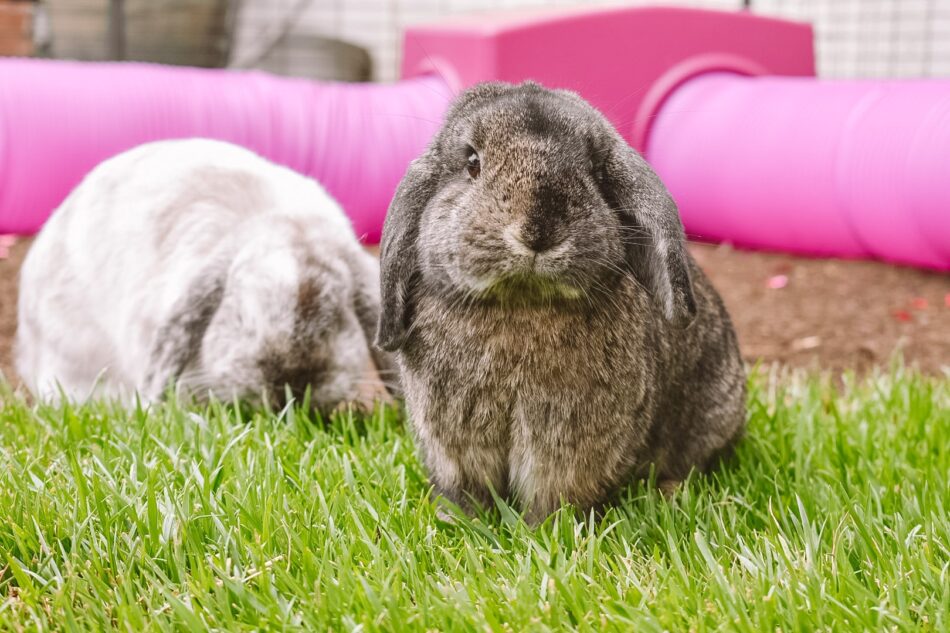
Your rabbit’s ear and nose
Rabbits use their ears to tune into what’s going on around them, and they can often be used as signals and are good indicators of how your rabbit is feeling. If the ears are stood up and are twitching, your rabbit is listening for something. If they are confident, it’s not dangerous, or not particularly interesting, they might only raise one ear. When they are relaxed, the ears will rest against the body, normally along the back.
The nose is also a good indicator of how the rabbit is feeling and how interested they are in what is going on around them. The faster the wiggling of the nose, the more attentive or agitated the rabbit is.
Happy rabbit body language
Fully closed eyes
Rabbits have very expressive eyes, and as they are prey animals, they will only fully close them when they are extremely comfortable and feel completely safe. So if you find your rabbits sleeping with their eyes closed, it is a clear sign that they feel at home.
The bunny flop
Your rabbit is rolling on its back with its legs in the air! This is a sign that the rabbit is really happy and relaxed, and the movement can sometimes be combined with a binky, which means that the bunny is running around and dancing madly, often jumping up in the air out of pure happiness.
Belly on the ground
The rabbit is lying on its belly with legs stretched out behind or maybe to the side of the body, with the head either up or resting on the ground. The rabbit is resting and is relaxed. The further the legs are stretched behind the body, the more comfortable the rabbit is.
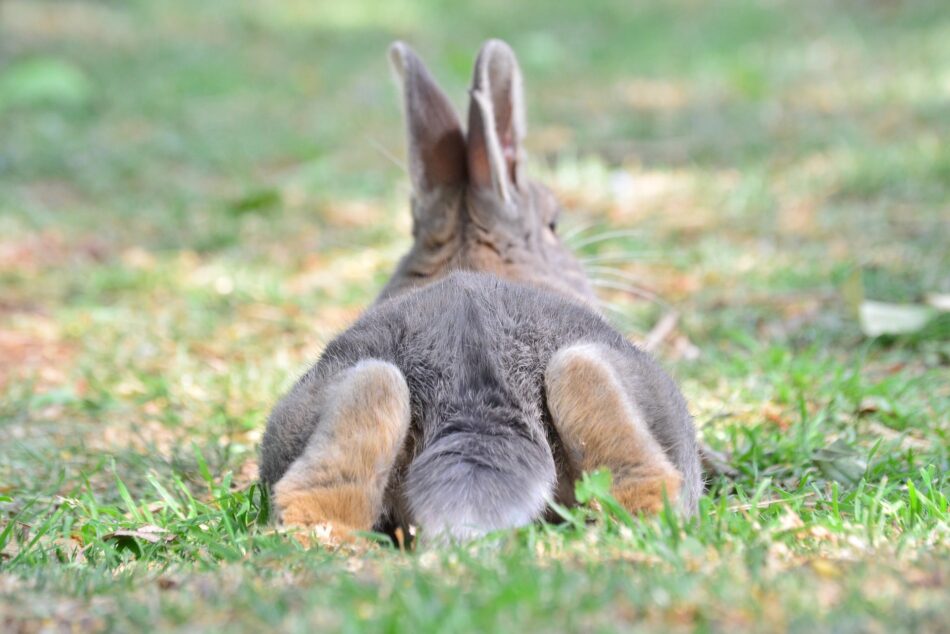
Rabbit bonding body language
If the rabbit is grooming itself when you are around it can be seen as a sign that your floppy-eared friend trusts you. Rabbits are prey animals and will never take their eyes off what they think might be an intruder.
Circling
Sometimes the rabbit starts running around your feet when you’re in the run with him or her. This is a mating ritual, and a sign that your rabbit is in love with you.
Nose rubbing
Rabbits tend to rub their noses in a way to show affection, so if you find your rabbit rubbing their nose on you it’s a sign that they really like you. If they also throw in a little lick, you’re properly loved! Discover more about How Rabbits Show Love and Affection in our previous blog.
Territorial body language
Rubbing scent glands
If you have a new hutch or run, the rabbit will have to make sure that its territory is marked. Rabbits do this by rubbing scent glands on their necks against objects, spraying urine and scattering their droppings around the place. This behaviour normally stops once the rabbit feels at home.
Stressed rabbit body language
Eyes wide open combined with fluffed up fur and growling indicate fear. The rabbit’s inner eyelids might also protrude and become visible if he or she is uncomfortable.
Other common rabbit body language
The classic
Rabbit is sat with weight on the bottom, forelegs straightened and ears standing up. Your rabbit is checking to see what’s going on (p.s. – the Zippi Rabbit Platforms for Zippi Runs provide bunnies with the perfect view of what’s happening in their backyard!).
Head on the ground
If the rabbit rests its head on the ground, he or she is showing submission, and might want to be petted or groomed. In different circumstances it can also mean that they want to be left alone, so make sure to take in other signals.
The ball
Rabbit is sat rolled up with legs tucked, normally with ears resting against the body. They are sleeping or napping. Rabbits can sleep with their eyes open but prefer to keep them closed if they feel comfortable and safe enough.
Nose nudge
This can either mean “leave me alone” or “you’re in my way”. It is however also a sign of trust, as you’re not seen as a threat to the rabbit.
Nest building
If you notice that your female rabbit starts pulling out hair from their fur and collects hay in a specific place in the hutch, it’s likely that she is building a nest. Rabbits sometimes have false pregnancies, but if you think that there is a possibility that your rabbit might be pregnant, it’s worth contacting your vet.
Sounds
Whilst rabbits mostly use body language to tell us how they’re feeling, our floppy-eared friends also communicate via sound. Rabbits are relatively quiet animals, but they do make a few noises that you’ll be able to differentiate from each other. Here are a few of them:
Growling
A short barking growl is a sign of aggression, and indicates that you, or something else close by, is threatening the rabbit.
Screaming
If the rabbit lets out loud, piercing screams they’re likely to be very scared or experiencing a lot of pain.
Low grunting and grinding of teeth
This is the rabbit equivalent of a cat’s purring and means that the rabbit is content and relaxed.
Loud teeth grinding and chattering
If the grinding however changes into louder teeth chattering, the rabbit is most likely in a lot of pain.
Thumping
Rabbits drum their feet against the ground when they are afraid or threatened or want to make others aware of what is going on. Thanks to the rabbit’s strong hind legs, this can be surprisingly loud.
Now you can read your rabbit, you can build an even better bond! Shop everything your pet needs in the Omlet Rabbit shop including Caddi Rabbit Treat Holders, Zippi Rabbit Platforms, and more! And if you do notice that your fluffy friend isn’t behaving in their normal manner, or you have any concerns about their body language or general health, do not hesitate to contact your vet.
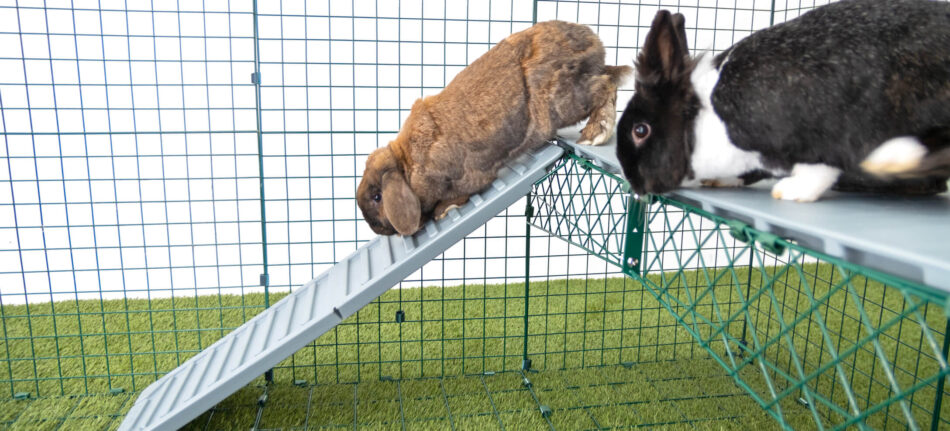
This entry was posted in Rabbits on March 4th, 2019 by linnearask
